List of stumbling blocks in Irsee
The list of the stumbling blocks in Irsee results by artist Gunter Demnig laid stumbling blocks in Irsee on.
The stumbling blocks laid in the former Benedictine monastery of Irsee Monastery are reminiscent of the victims of the " euthanasia murders" during the Nazi era .
From 1939 to 1945 more than 2000 patients, including many children, were abolished in the Kaufbeuren-Irsee sanatorium , initially as part of Action T4 and after the "official" end of Action T4 in 1941 as part of the so-called "wild euthanasia" 1943 deported to extermination centers as part of Aktion Brandt . Many died of malnutrition , which was legalized by the " Hunger Food Decree " of November 30, 1942, or were killed directly by injections of overdosed drugs .
The aim of this list is to document biographical details about the people, partly supplemented by information and comments from Wikipedia articles and external sources in order to preserve their memory.
- Note: In many cases, however, it is no longer possible to comprehend a complete description of their life and their path of suffering. In particular, the circumstances of her death can often no longer be researched. Official death notices from hospitals can often contain information that obscures the true circumstances of the death, but are documented with this fact in mind.
| image | Name and details of the inscription | address | Additional Information |
|---|---|---|---|

|
Alois Bauer lived here , ( born 1876)
|
Irsee Monastery ( location ) |
The Stolperstein, which was laid on September 14, 2015, commemorates Alois Bauer , born on April 23, 1876 in Bodenstein (Catholic).
Alois Bauer was the son of a carpenter and had no professional training himself and worked as a day laborer . Alois Bauer was delinquent from the June 16, 1934 prison Straubing in the nursing home of the Brothers of Charity in Straubing laid. Without a family and without a permanent residence, the costs of the accommodation were borne by the Landesführsorgeverband Schwaben . On November 20, 1940, Alois Bauer was taken to the Kaufbeuren sanatorium . Alois Bauer was transferred to the Irsee Monastery branch as a “care case” and “unable to work” . There Dr. Lothar Gärtner noted in the medical file on January 3, 1941: “confused hallucinant” , “schizophrenic” and “full of delusional ideas” . Finally, on June 4, 1941, Alois Bauer was transferred from the Irsee Monastery to the Hartheim killing center , where he was murdered in the gas chamber . |
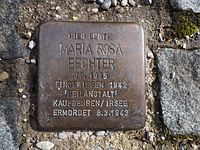
|
Maria Rosa Bechter lived here , ( born 1935)
|
Irsee Monastery ( location ) |
The Stolperstein laid on May 16, 2009 commemorates Maria Rosa Bechter , born on February 12, 1935.
Maria Rosa Bechter was murdered on March 8, 1943 in the so-called “ children's department ” in Kaufbeuren. |

|
Rosina Biehler lived here , ( born 1873)
|
Irsee Monastery ( location ) |
The Stolperstein, which was laid on September 14, 2015, commemorates Rosina (Rosa) Biehler , born on February 4, 1873 in Anhausen (Catholic).
The maid Rosa Biehler was admitted to the Irsee sanatorium on May 17, 1898 and was transferred from Irsee Monastery to the Grafeneck killing center on August 27, 1940 , where she was murdered. |
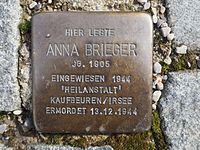
|
Anna Brieger lived here , ( born 1905)
|
Irsee Monastery ( location ) |
The Stolperstein, which was laid on May 16, 2009, commemorates Anna Brieger , born on November 22, 1905 in Dittersdorf near Striegau (Silesia) as Anna Dorothea van Klaeden (Protestant).
Anna Dorothea van Klaeden was married to the Jewish doctor Heinrich Brieger and was the mother of a son. Heinrich Brieger emigrated to America with his four children from his first marriage in 1938; his wife did not receive an entry permit. In 1939 Anna Brieger was admitted to the Westend sanatorium in Berlin-Charlottenburg by her siblings because of “general unrest, confused speeches and a negative attitude” . In the summer of 1940 Anna Brieger was transferred to the private institution Tannenfeld in Nöbdenitz (Thuringia). Her husband suggested that his wife should be treated with electroshock therapy for schizophrenia . Since this therapy was not possible in the private institute Tannenfeld , Anna Brieger was transferred to the University Psychiatric Clinic in Leipzig on May 9, 1942 . From May 13, 1942 to July 21, 1942, 20 shock treatments were performed with little success. At the family's request, ten more electric shock attempts were made. Her stay in the Wahrendorff private clinic in Ilten near Hanover is documented from September 11, 1942 . In the summer of 1943, another unsuccessful attempt at therapy with the anti- spasmodic Azoman from Boehringer & Sohn was made. Anna Brieger was finally transferred on November 16, 1944 with a transport of 149 patients from Ilten to the Irsee sanatorium . Anna Dorothea Britzer (Briegger) was murdered there on December 13, 1944 by the nurse Pauline Kneißler on the ward in the "Landhaus" also called "Tobhaus" or "House for restless women" (Irsee Monastery) using overdosed drugs . " Hsch " was recorded as the cause of death in the death register of the Irsee sanatorium . |
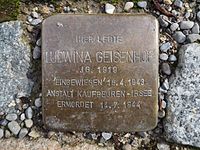
|
Ludwina Geisenhof lived here , ( born 1919)
|
Irsee Monastery ( location ) |
The Stolperstein, which was laid on September 14, 2015, commemorates Ludwina (called Lydia) Geisenhof , born on September 28, 1919 in Pfronten-Ried (Catholic).
Lydia Geisenhof was admitted to the Kaufbeuren sanatorium for the first time in 1940 because of “ melancholy ” and “ risk of suicide ” . The director of the institution there, Dr. Valentin Faltlhauser recommended treatment with an insulin cure because of "undoubted schizophrenia " . After completing the treatment, Lydia Geisenhof lived with her parents again. On April 16, 1943, she was again admitted to the Kaufbeuren asylum by the medical officer because of “ mental illness ” and “ public danger ” and treated with electroshock therapy. After a treatment series of 20 electric shocks, her mental and physical condition deteriorated and Lydia Geisenhof was in need of care and was temporarily isolated. Her condition improved somewhat when her mother Albertine Geisenhof (born April 14, 1896 in Rieden near Aitrach) was also admitted to the Kaufbeuren sanatorium because of a “ nervous breakdown ” and “ addiction to morphine ” . In the medical file it was noted: "[Ludwina Geisenhof] goes to the bed of her seriously ill mother a lot, stands next to her at the head end, speaks nothing, does not touch her, just stares." Her mother dies on January 19, 1944 a septicemia due to a purulent decubitus . An X-ray examination revealed that Lydia Geisenhof had "extensive tuberculosis over both lungs" , whereupon she was transferred to the Irsee Infection Department on July 11, 1944 . Lydia Geisenhof was murdered on July 14, 1944 on the ward in the main building of the Irsee Monastery by the nurse Pauline Kneißler with an overdose of Luminal . In the death register of the Irsee sanatorium , Dr. Lothar Gärtner noted " L-Tbc " as the cause of death . |
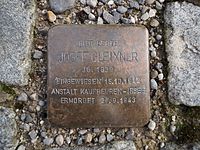
|
Josef Gleixner lived here , ( born 1939)
|
Irsee Monastery ( location ) |
The Stolperstein, which was laid on September 14, 2015, commemorates Josef Gleixner , born on July 27, 1939 in Kempten (Catholic).
Josef Gleixner was the youngest son of the train driver Johann Gleixner and his wife Maria. Two of her six children died at an early age. When Josef Gleixner was born on July 27, 1939, his mother Maria also died. As a sick child (including rickets and septic otitis ) , three-year-old Josef Gleixner was diagnosed with " nonsense " in the Munich-Schwabing Municipal Hospital . As “violent and unstoppable” , home care would no longer be possible. On the advice of the doctors, Josef Gleixner's stepmother took him to the Kaufbeuren sanatorium on October 15, 1942 . There he was assigned to the “ children's department ” for selection. After CSF and X-ray examinations , the diagnosis “ water head ” was made there. During his stay he received visits from his parents and siblings several times. On September 14, 1943, Josef Gleixner was relocated to Irsee Monastery . Contrary to the entries of the nursing staff, which Josef Gleixner noted as an "unclean, peaceful child who did not cause any problems for the staff", Dr. Lothar Gärtner in the medical record: “Vegetates helplessly, unclean with excrement and Urine; in need of care in all pieces; Food must be entered ... without utterance. " Josef Gleixner died on November 27, 1943. The funeral took place in the presence of his parents at the Irsee institutional cemetery . In the death register of the Irsee sanatorium , Dr. Lothar Gärtner noted " pneumonia " as the cause of death . |
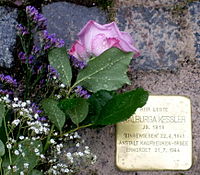
|
Walburga Kessler lived here , ( born 1918)
|
Irsee Monastery ( location ) |
The Stolperstein, which was laid on September 14, 2015, commemorates Walburga Kessler , born on October 9, 1918 (Catholic) in Burgberg .
Walburga Kessler, called "Wally", was the daughter of Adolf and Julianna "Julie" Kessler (née Schmid) . Walburga Kessler was the fourth of six children in the family. According to oral tradition, Wallburga Kessler could neither hear nor speak and as a toddler could not walk independently and was therefore constantly carried by her mother. At the age of 44, his mother died on February 12, 1928 in the hospital in Sonthofen . With effect of the pol. District Bregenz from January 3, 1929 Walburga Kessler received a certificate of citizenship and national law in Austria. On January 7, 1929, the father brought Walburga to the Jesuheim in Lochau on Lake Constance in Austria. After Austria's annexation in 1938, Walburga Kessler was classified by the community doctor as “crippled” , “incapable of education” and “incurable” in an official medical report . On February 27, 1941, she was picked up by the German Red Cross and transferred to the Valduna sanatorium . There she was referred to as a “deaf-mute idiot” on March 24, 1941 and transferred to the sanatorium in Hall in Tyrol. In the medical file it was noted: “Walburga Kessler was bedridden, behaved quietly, did not need any medication, was completely in need of care and assistance. Whenever Walburga saw the doctor or someone from the staff approaching her, Walburga would laugh happily, for example, to make it clear when she had had enough while eating, and was happy when someone had something to do with her. Cried when leaving the institution, but seemed to understand that she was leaving here ” . Walburga Kessler was later transferred to the Kaufbeuren sanatorium and on September 2, 1941, to Irsee Abbey . In the Irsee institution , Walburga Kessler was malnourished by means of a specially dosed, fat-free starvation diet ("E-diet"). With a telegram dated July 31, 1944, the father was informed: “Walburga is critically ill. Visits cannot be permitted due to the risk of infection. Irsee Institution ” . A little later another telegram followed with the news of his death. Walburga Kessler was murdered on July 31, 1944 by the nurse Pauline Kneißler on the ward in the main building of the Irsee Monastery . In the registry of the dead at the Irsee sanatorium, the cause of death was " suspected type " . The coronary certificate was issued with the note of the cause of death " heart failure " by the senior physician at the Irsee sanatorium, Dr. Lothar Gärtner issued and signed. On July 1, 2014, another stumbling block for Walburga Kessler was laid in Burgberg, where she was born. |
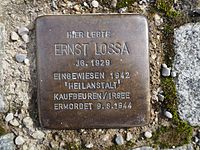
|
Ernst Lossa lived here , ( born 1929)
|
Irsee Monastery ( location ) |
The Stolperstein laid on May 16, 2009 commemorates Ernst Lossa , born on November 1, 1929 in Augsburg .
Ernst Lossa belonged to the Yenish minority . His mother Anna Lossa died in 1933 when he was four years old. His father Christian Lossa was from the Nazis persecuted as "Gypsies" and in the 1939 concentration camp (KZ) Dachau brought. According to various reports, his father died in Mauthausen or Flossenbürg . Ernst Lossa and his two sisters were placed in a children's home in Augsburg-Hochzoll . Ernst Lossa committed a few thefts in the school there. On February 15, 1940, Ernst Lossa came to the Indersdorf youth education center near Dachau on the grounds that he was “uneducable” , where he was accused of numerous other thefts. It was created by Dr. Katharina Hell from the German Research Institute for Psychiatry in Munich prepared a psychiatric report which summarized that Lossa was "undoubtedly a good-natured, but completely unwilling, unfounded, almost average gifted, instinctual psychopath " . "With his strong instinctuality, he will probably not be able to be significantly improved" . The equality of length of the ring and index finger of the right hand was noted as a "sign of degeneration" in the report. Enst Lossa was then forcibly committed to the children's department of the Kaufbeuren sanatorium on April 20, 1942 . There he continued to behave conspicuously and inappropriately, but according to later statements by employees of the sanatorium he was also valued because he was kind and helpful. He often tried to give food to starving sick people that he had previously stolen. Lossa was transferred to the Irsee branch on May 5, 1943 , where he was murdered on August 9, 1944 with the "lethal injection". In his coronary certificate, “Asocial psychopath” was entered as the “basic ailment ”, “ Bronchopneumonia ” as the “cause of death ” and the Irsee institution as the place of death. The corpse certificate was issued by the deputy medical director of Kaufbeuren and senior physician from Irsee, Dr. Lothar Gardener. In his testimony, a male nurse later stated that he had refused to inject Lossa to death with Luminal . He then watched the nurse Pauline Kneißler Lossa in the presence of Dr. Valentin Faltlhauser and administration manager Josef Frick administered an injection, whereby Lossa was persuaded that it was a vaccination against typhus . |

|
Here lived Karoline Josephine Thomas , ( born 1884)
|
Irsee Monastery ( location ) |
The Stolperstein, which was laid on September 14, 2015, commemorates Karoline Josefine Thomas , born on December 16, 1884 (or April 1 or April 21, 1884) in Nördlingen as Karoline Josefine Besel (Catholic).
Karoline Besel worked as a maid from the age of 15 . In 1906 she married the local hairdresser Fritz Thomas in Berg / Thurgau , ran the household and worked in her husband's hairdressing business. In 1916 Karoline Thomas was hospitalized for four weeks in the Kilchberg Sanatorium for the first time because of depression . On August 12, 1927, he was admitted to the psychiatric institution in Münsterlingen on Lake Constance because of "sudden excitement " . As a German citizen, Karoline Thomas was transferred to the Kaufbeuren sanatorium on December 23, 1927 . In 1930 the city of Berg demanded a psychiatric report "in order to initiate a paternalistic procedure" . A " schizophrenic psychosis " was diagnosed by the Kaufbeurer appraiser and recommended to pronounce incapacitation due to " mental weakness " . Her health did not improve and so Karoline Thomas was transferred to the Irsee Monastery on July 20, 1931 . In the medical file of the Irsee sanatorium , “restless behavior, hallucinations and destruction ... at times a little calmer” is noted. Visits from her husband or sister are not documented. On May 6, 1932, Fritz Thomas asked for the last time by post for information about the condition of "Lina Besel divorced Mrs. Thomas" . Karoline Thomas was transferred to the Grafeneck killing center on August 27, 1940 , and murdered there. |

|
Konrad Viertler lived here , ( born 1933)
|
Irsee Monastery ( location ) |
The Stolperstein, which was laid on September 14, 2015, commemorates Konrad Viertler , born on February 12, 1933 (Catholic) in Gsies-Pichl , South Tyrol.
Konrad Viertler was the son of Anna and Simon Viertler and had eight siblings. After the Hitler-Mussolini Agreement of October 21, 1939 on the resettlement of the German population in South Tyrol, the Viertler family was settled in Prenning near Deutschfeistritz (Styria). During the routine examinations for naturalization , Konrad Viertler found limitations in his mental and physical development. The mother took him to the St. Josef Institute in Mils near Hall in Tirol. On August 27, Konrad Viertler and nine other South Tyrolean children were transferred from Mils to the children's department of the Kaufbeuren sanatorium at the instigation of the "Reich Committee for the Scientific Assessment of Hereditary and Constitutional Serious Ailments" . The family was not informed of this until weeks later. While the other nine South Tyrolean children were used for TB vaccination attempts, Konrad Viertler did not enter any medical treatments in the medical records. His condition is shown in the medical record as “always the same dull” or “ clumsy” , “equally clumsy” and “ clumsy ” with the comment “unchanged condition”. Lately uncomfortable because he bites the other boys ” , described. On June 22, 1943, Konrad Viertler was transferred to the Irsee Monastery . Konrad Viertler died on October 12, 1943. In the death register of the Irsee sanatorium , the cause of death was noted as " pneumonia ". It is very likely that Konrad Viertler was murdered using overdosed drugs. |
Individual evidence
- ↑ History of the Irsee Monastery
- ↑ Magdalene Heuvelmann: The Irseer Totenbuch - chronological register of the dead of the Irsee sanatorium from 1849 to 1950 . 1st edition. Grizeto Verlag, Irsee 2015, ISBN 978-3-9816678-2-0 , p. 264-265 u. 392-393 .
- ↑ Magdalene Heuvelmann: The Irseer Totenbuch - chronological register of the dead of the Irsee sanatorium from 1849 to 1950 . 1st edition. Grizeto Verlag, Irsee 2015, ISBN 978-3-9816678-2-0 , p. 10 .
- ↑ Magdalene Heuvelmann: The Irseer Totenbuch - chronological register of the dead of the Irsee sanatorium from 1849 to 1950 . 1st edition. Grizeto Verlag, Irsee 2015, ISBN 978-3-9816678-2-0 , p. 250-251 u. 390-391 .
- ↑ Note : Name entry in the registry of the dead of the Irsee sanatorium (source document Magdalene Heuvelmann: Das Irseer Totenbuch - chronological register of the dead at the Irsee sanatorium from 1849 to 1950. 1st edition. Grizeto Verlag, Irsee 2015, ISBN 978-3- 9816678-2-0 , p. 315 . ) entered.
- ↑ Magdalene Heuvelmann: The Irseer Totenbuch - chronological register of the dead of the Irsee sanatorium from 1849 to 1950 . 1st edition. Grizeto Verlag, Irsee 2015, ISBN 978-3-9816678-2-0 , p. 314-315 et al. 414-415 .
- ↑ Magdalene Heuvelmann: The Irseer Totenbuch - chronological register of the dead of the Irsee sanatorium from 1849 to 1950 . 1st edition. Grizeto Verlag, Irsee 2015, ISBN 978-3-9816678-2-0 , p. 302-303 et al. 404-405 .
- ↑ Magdalene Heuvelmann: The Irseer Totenbuch - chronological register of the dead of the Irsee sanatorium from 1849 to 1950 . 1st edition. Grizeto Verlag, Irsee 2015, ISBN 978-3-9816678-2-0 , p. 286-287 et al. 398-399 .
- ↑ Magdalene Heuvelmann: The Irseer Totenbuch - chronological register of the dead of the Irsee sanatorium from 1849 to 1950 . 1st edition. Grizeto Verlag, Irsee 2015, ISBN 978-3-9816678-2-0 , p. 302-303 et al. 406-408 .
- ↑ Gedenkort-t4.eu: Walburga Kessler - Researched by Matt Kessler ( Memento of the original from November 14, 2015 in the Internet Archive ) Info: The archive link was inserted automatically and has not yet been checked. Please check the original and archive link according to the instructions and then remove this notice. , accessed September 27, 2015
- ↑ a b c Michael von Cranach, Hans-Ludwig Siemen (ed.): Psychiatry in National Socialism. The Bavarian sanatoriums and nursing homes between 1933 and 1945 , pp. 475–484
- ↑ Cranach, 1999, pp. 478 and 479f.
- ↑ Magdalene Heuvelmann: The Irseer Totenbuch - chronological register of the dead of the Irsee sanatorium from 1849 to 1950 . 1st edition. Grizeto Verlag, Irsee 2015, ISBN 978-3-9816678-2-0 , p. 409-411 .
- ↑ Magdalene Heuvelmann: The Irseer Totenbuch - chronological register of the dead of the Irsee sanatorium from 1849 to 1950 . 1st edition. Grizeto Verlag, Irsee 2015, ISBN 978-3-9816678-2-0 , p. 304-305 et al. 409-411 .
- ↑ Magdalene Heuvelmann: The Irseer Totenbuch - chronological register of the dead of the Irsee sanatorium from 1849 to 1950 . 1st edition. Grizeto Verlag, Irsee 2015, ISBN 978-3-9816678-2-0 , p. 252-253 et al. 388-389 .
- ↑ Note : Contrary to the date of death on the Stolperstein, October 12, 1943 was entered in the registry of the dead at the Irsee sanatorium Magdalene Heuvelmann: The Irseer Totenbuch - chronological register of the dead at the Irsee sanatorium from 1849 to 1950 . 1st edition. Grizeto Verlag, Irsee 2015, ISBN 978-3-9816678-2-0 , p. 286 .
- ↑ Magdalene Heuvelmann: The Irseer Totenbuch - chronological register of the dead of the Irsee sanatorium from 1849 to 1950 . 1st edition. Grizeto Verlag, Irsee 2015, ISBN 978-3-9816678-2-0 , p. 286-287 et al. 400-401 .
literature
- Magdalene Heuvelmann : The Irseer Totenbuch - chronological register of the dead of the Irsee sanatorium from 1849 to 1950 . 1st edition. Grizeto Verlag, Irsee 2015, ISBN 978-3-9816678-2-0 , p. 496 .
- Michael von Cranach , Hans-Ludwig Siemen (Ed.): Psychiatry in National Socialism. The Bavarian sanatoriums and nursing homes between 1933 and 1945 . 2nd Edition. Oldenbourg Verlag, Munich 2012, ISBN 978-3-486-71451-7 , p. 508 .
Web links
- Gunter Demnig's website for the Stolperstein project
- Kreisbote.de: Commemoration of euthanasia victims "stumbling with head and heart"
- stolpersteine-augsburg.de:In memory of the victims of euthanasia: More STOLPERSTEINE at Irsee Monastery
- Video: New stumbling blocks in Irsee
- Youtube video for laying on September 14, 2015

